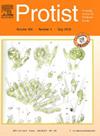Diversity of Kryptoperidinium (Peridiniales, Dinophyceae): Morphological description and molecular phylogenetics of Kryptoperidinium secundum sp. nov.
IF 2.1
3区 生物学
Q4 MICROBIOLOGY
引用次数: 0
Abstract
Kryptoperidinium belongs to a group of dinophytes hosting a diatom as an endosymbiont and is currently considered to comprise a single, putatively bloom-forming and harmful species only. Molecular phylogenetics indicate the existence of a second distinct lineage and therefore species new to science, which we here formally describe as Kryptoperidinium secundum sp. nov. We studied living and fixed material of unialgal strains in detail using light and electron microscopy and gained DNA sequences of the rRNA complex (hosts and endosymbionts, from which also psbA and rbcL sequence data were obtained). In a molecular phylogeny of the Bacillariophyceae, the endosymbionts of K. secundum have a divergent position from those of Kryptoperidinium triquetrum (=K. foliaceum) and show (once more) a close relationship to free-living diatoms. The cells of K. secundum were strongly dorso-ventrally compressed and exhibited the thecal plate formula po, X, 4′, 2a, 7′′, 5C, 6(?)S, 5′′′, 2′′′′. The distalmost precingular plate was consistently rectangular in shape and relatively broad, and this is the key diagnostic trait to distinguish K. secundum from the known K. triquetrum, which has a characteristically L-shaped plate with a thin and elongated base. The two species are clearly divergent in molecular phylogenetics (exhibiting long branches) and constitute a monophyletic group together with Dinothrix sharing the same thecal plate formula. The diatom phylogeny favours an evolutionary scenario of repeated plastid capture rather than strict co-divergence between dinophyte hosts and their endosymbionts.
潜甲的多样性:潜甲科潜甲科潜甲的形态描述和分子系统发育。
Kryptoperidinium属于一组以硅藻为内共生体的dinophytes,目前被认为是单一的,推定的开花和有害的物种。分子系统发育表明存在第二种不同的谱系,因此是科学上的新物种,我们在这里正式描述为Kryptoperidinium secundum sp. 11 .我们使用光镜和电子显微镜详细研究了单藻菌株的生活和固定物质,并获得了rRNA复合物的DNA序列(宿主和内共生体,从中也获得了psbA和rbcL序列数据)。在硅藻科的分子系统发育中,K. secundum的内共生体与Kryptoperidinium triquetrum (=K. .)的内共生体具有不同的位置。并再次显示出与自由生活的硅藻的密切关系。第二芽的细胞呈强烈的背腹压缩,呈现出鞘板公式po, X, 4 ', 2a, 7 ', 5C, 6(?)5英寸,2英寸。远端骨楔前板呈矩形且相对较宽,这是区分第二骨楔与已知的三骨楔的关键诊断特征,后者具有典型的l形板和细长的基底。这两个物种在分子系统发育上明显不同(表现出长分支),并与恐龙组成一个单系群,共享相同的鞘板配方。硅藻的系统发育倾向于重复质体捕获的进化情景,而不是在双植物宿主和它们的内共生体之间严格的共同分化。
本文章由计算机程序翻译,如有差异,请以英文原文为准。
求助全文
约1分钟内获得全文
求助全文
来源期刊

Protist
生物-微生物学
CiteScore
3.60
自引率
4.00%
发文量
43
审稿时长
18.7 weeks
期刊介绍:
Protist is the international forum for reporting substantial and novel findings in any area of research on protists. The criteria for acceptance of manuscripts are scientific excellence, significance, and interest for a broad readership. Suitable subject areas include: molecular, cell and developmental biology, biochemistry, systematics and phylogeny, and ecology of protists. Both autotrophic and heterotrophic protists as well as parasites are covered. The journal publishes original papers, short historical perspectives and includes a news and views section.
 求助内容:
求助内容: 应助结果提醒方式:
应助结果提醒方式:


